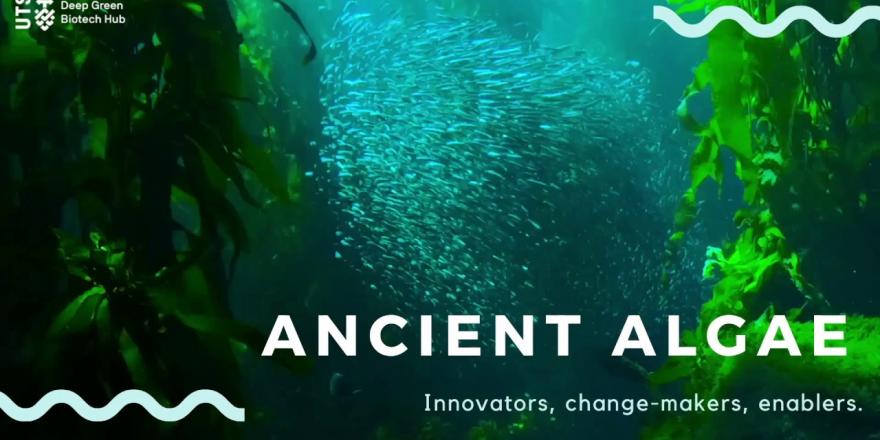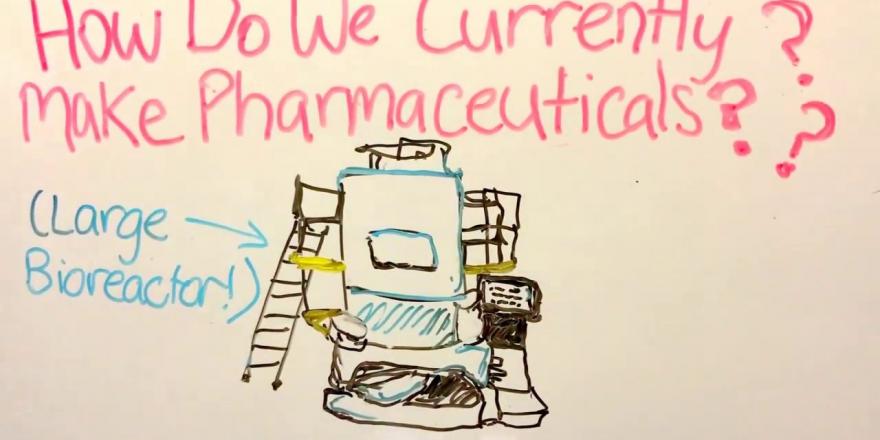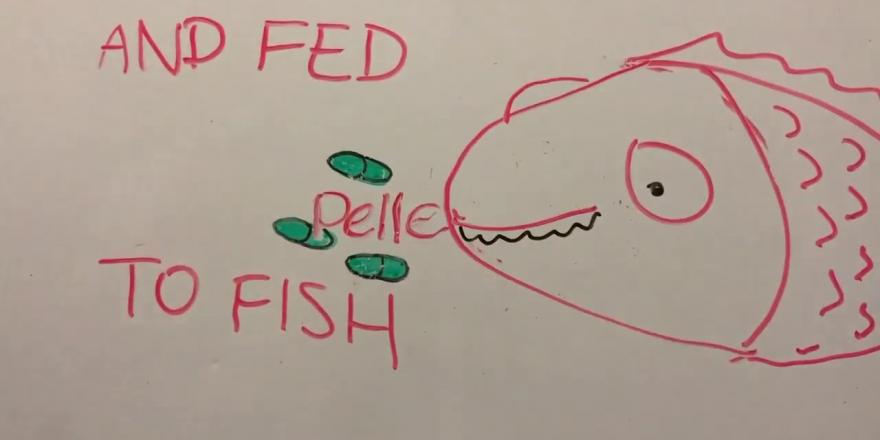DGBH seeks to further connect and stimulate awareness of algae biotechnology. We do this by providing resources, curating public events, and creating education and outreach activities. Below are some examples of our activities, feel free to contact us if you’d like to discuss.
What is algae?
About algae
Amazing Algae: Harnessing biology for a sustainable future

This is the amazing story of an ancient and little known organism that has the potential to transform the way we live, produce and consume.
Algae are the earliest ancestors of all plants, first appearing around 2.5 billion years ago.
Since then they have diversified to somewhere between 30 000 to 1 million different species, coming in all different shapes and sizes.
Microalgae are tiny cells, invisible to the naked eye and smaller than the diameter of a human hair.
Macroalgae are more complex and made of many cells - with some species, like kelp, reaching lengths of nearly 60m.
Anywhere there is water, algae can grow. They are abundant in the oceans and in rivers, lakes and streams.
Most algae are photosynthetic, which means they use the sun’s energy to turn water and carbon dioxide in the air into sugar for energy.
Algae are the forests of the ocean, and collectively produce up to 50% of the Earth’s oxygen - you can thank algae for every second breath you take.
Just like plants, algae convert the sugars from photosynthesis into 3 important products to build their cells - protein, carbohydrates, and oils. .
But they can do this much faster, with some species able to double in size in just 24 hours.
Furthermore, algae only needs a fraction of the land area and water to grow the same amount of protein in a steak or a piece of tofu.
This means algae doesn’t compete for land or precious resources.
Algae are efficient and sustainable little biofactories, and scientists and business are exploring algae alternatives for a variety of industries - including food, pharmaceuticals and cosmetics, animal feed for livestock and aquaculture, pigments, fertiliser, bioplastic for packaging, and materials for clothing and footwear.
Algae can even utilise waste streams to grow - including excess nutrients from wastewater and captured carbon dioxide from industry.
In this way, algae can create products and processes that are carbon neutral, climate friendly, sustainable and better for the health of communities and the environment.
A greener, brighter future is possible with algae.
To learn more visit us at the Deep Green Biotech Hub.
What exactly is algae? Algae is a photosynthetic plant that grows in water. In some cases, this plant can be large and complex, such as seaweed (which is called “macroalgae”). In other cases, algae can be both microscopic and simple, with each individual plant – or cell – being invisible to the naked eye. This algae – called “microalgae”- can be found in rivers, dams, lakes, waterways, and oceans across the world, and produce about 50% of the oxygen we breathe.
While we can’t see the individual cells with the naked eye, together microalgae can grow and group together, turning the water it lives and grows in brilliant shades of green, red, and gold. In some cases, this microalgae can be bio-luminescent, transforming the ocean it lives in to a brilliant glowing environment.
Ancient Algae: Change-makers, innovators and enablers of life as we know it

Algae are arguably some of the most successful forms of life on the planet.
And though you might not know it, you and I and everyone we know is alive today because of their success.
Over a period of several million years, the changes brought about on Earth by these organisms created the conditions for life as we know it to evolve.
If you hopped in a time-machine and travelled back two and a half billion years, you wouldn’t be able to breathe - There was almost no oxygen.
Life had first appeared on Earth a million years earlier, in the form of simple organisms like bacteria. This early life thrived in an atmosphere thick with volcanic gases like nitrogen, methane, carbon dioxide and sulphur.
In the shallow seas of this hostile world, an organism called cyanobacteria evolved a remarkable way of acquiring energy, known as photosynthesis
In doing so, they seeded the atmosphere with oxygen for the first time.
And over the next billion years, cyanobacteria produced enough oxygen to change the world forevermore.
Initially, this caused a mass extinction, as the oxygen algae created was poisonous to much of the existing bacterial life on Earth. However, it set in motion an astonishing, life-giving possibility...
By 600 million years ago, the abundance of oxygen created by algae caused the ozone layer to spontaneously form around the Earth, which offered protection from the sun’s most harmful UV radiation.
This incredible biochemical protection allowed early life to emerge from the deep oceans and the evolution of higher plants and forests, which in turn, increased the amount of oxygen in the atmosphere.
With an abundance of plants for food, and oxygen to create energy, organisms grew to be larger, and more mobile.
Without algae, life on this planet may never have evolved beyond a single cell.
Algae’s earliest ancestors have now evolved to over 70 000 known species, which drive life in the oceans, and in freshwater lakes and rivers.
Algae play an important role in global oxygen production and carbon storage in the oceans, and have adapted to live in deserts, glaciers and soils and even with other organisms as coral and lichen.
Algae played an important role in our past, and will play an important role in our future too. Today, scientists are turning to these innovative change-makers to help solve some of the most pressing modern sustainability problems of our time.
To learn more visit the Deep Green Biotech Hub.
Algae first appeared on Earth about 2.5 billion years ago. Responsible for producing Earths atmosphere, these algae are the ancestors of the modern species that exist on Earth today. Algae is a crucial part of our environment. Not only does it capture carbon and provide oxygen, but it also forms an important part of aquatic food webs. Scientists estimate that there are anywhere between 30 000 and 1 million species of algae on Earth, and these plants can live in a variety of conditions; from the cold icy waters of Antarctica, to mountain top lakes, to tropical rain forests.
Algae Futures: Sustainable solutions with biotechnology

Nature has long been a source of inspiration for innovation,
And in the face of multiple, interconnected sustainability problems, scientists and businesses are turning to algae to innovate for a greener future.
Many of our modern processes for producing materials are unsustainable and put pressure on environmental health.
At current rates of consumption, we are exhausting one year’s worth of resources in just six months, or roughly double what the Earth can sustain.
By 2050, unless we change the way we do things, our 9 billion-strong population will require the equivalent of 3 Earth’s worth of resources.
Algae have the potential to help reduce demand on the world’s resources.
Like efficient solar-powered biofactories – algae convert abundant sunlight, carbon dioxide, water and nutrients into useful compounds.
These compounds in algae cells can be harnessed to create renewable and sustainable alternative materials.
Algae can be a substitute for the petrochemicals that are used in a multitude of products, including:
Plastics, synthetic fabrics like nylon and polyester, shoes, surfboards, paints, pigments in our food and even beauty products!
Petrochemicals are compounds made from fossil fuels which need to be extracted and processed, emitting carbon dioxide in the process.
Algae, on the other hand, can be grown using endlessly renewable sunlight - absorbing carbon dioxide in the process.
Using more climate-friendly algae alternatives offers a way to reduce our reliance on fossil fuels.
Algae has a tiny water and land footprint compared to other protein sources, and can be grown anywhere there is abundant sunlight – even in deserts and on rooftops.
Algae is nutrient rich, and full of protein and healthy fats like Omega 3.
This means algae can offer a sustainable alternative to protein sources, fish oil supplements and feed for livestock and aquaculture operations.
In doing so, algae-based foods can reduce the pressures of overfishing, deforestation, land degradation and pollution.
Not only can algae offer biodegradable alternatives to plastics and packaging, they also have the potential to clean up our air and waterways.
Algae can absorb the excess nutrients in wastewater, and carbon emissions from industry or breweries.
It can then be harvested and turned into products, transforming waste into a resource.
Algae will enable multiple industries to transition to more sustainable business models.
Algae solutions form part of an emerging bio-economy worth billions of dollars, creating green jobs and contributing to future prosperity, without putting pressure on the Earth’s precious resources
To learn more about algae futures, visit us at the Deep Green Biotech Hub.
Algae has a diverse range of applications across a multitude of industries. Algae is high in compounds such as lipids and proteins, therefore making it both valuable and useful. In many cases, products made from algae can be the solution to resource exhaustion. For example, algae that grow in bodies of water such as lakes and dams, can be harvested and processed to make products that would usually be made out of petroleum.
Some companies are working with the Deep Green Biotech Hub to use microalgae to substitute ingredients in a range of products, such as nutraceuticals, vitamins, dietary supplements, and for use in sustainability projects.
What can you do with algae?
Algae in pharmaceuticals
Algae cells have many benefits in the pharmaceutical industry over those that have been traditionally used in the past.

[Music]
Using algae to feed the world
How can algae be used to feed the world? Algae is high in compounds such as lipids and proteins, therefore making it both valuable and useful.

[Music]
Algae as a feedstock alternative
How can algae be used as a sustainable alternative to traditional feedstocks used in commercial fish farms?

[Music]
Contact us to access more resources for teachers
